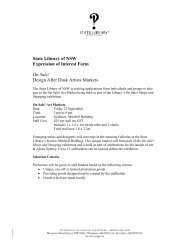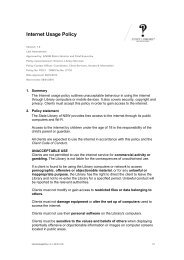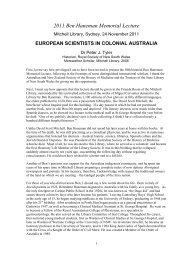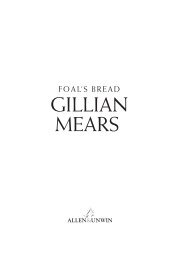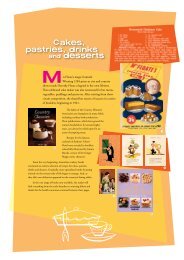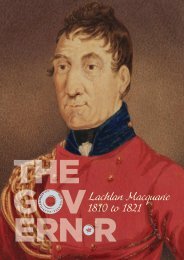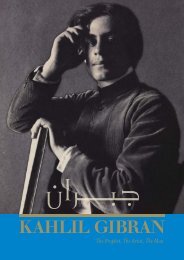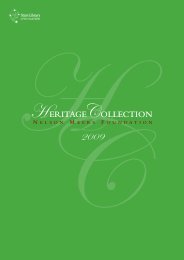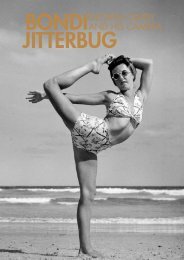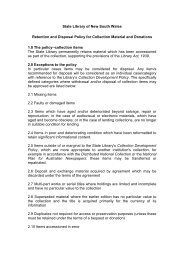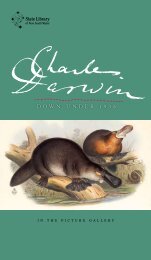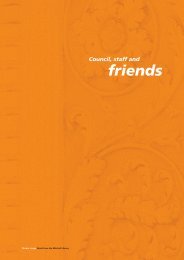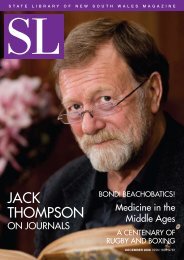Countdown to Mitchell centenary - State Library of New South Wales
Countdown to Mitchell centenary - State Library of New South Wales
Countdown to Mitchell centenary - State Library of New South Wales
Create successful ePaper yourself
Turn your PDF publications into a flip-book with our unique Google optimized e-Paper software.
f r e n z y f o r f r e n C h f a s h i o n<br />
experience first-hand the rarefied ambience <strong>of</strong><br />
Parisian haute couture (high fashion) houses. For the<br />
small number <strong>of</strong> Australians who travelled regularly<br />
and could afford it, haute couture could be purchased<br />
directly from these exclusive establishments,<br />
provided one had the right introductions, and the<br />
time <strong>to</strong> undertake several fittings and wait a month<br />
for the garments <strong>to</strong> be completed.<br />
Back home, several couture salons had opened in<br />
Sydney during the interwar period. Bearing French<br />
names, and cashing in on the prestige <strong>of</strong> Paris fashion<br />
and all things French, these businesses modelled<br />
their operations on French workrooms. Local<br />
couturiers like Madam Rochas, Paulette Pellier,<br />
Germaine Rocher, and milliner Henriette Lamotte,<br />
numbered among their clientele the wives and<br />
daughters <strong>of</strong> successful business men, female<br />
members <strong>of</strong> important Australian families and<br />
leading Sydney socialites.<br />
Australian women could also buy French fashion<br />
through the better department s<strong>to</strong>res such as<br />
Sydney’s Mark Foys and David Jones. The latter<br />
was particularly noted for its French salon,<br />
where shoppers could select from an array <strong>of</strong><br />
ready-made gowns.<br />
By the end <strong>of</strong> World War II, people were ready <strong>to</strong><br />
indulge themselves after years <strong>of</strong> wartime austerity.<br />
The troops came home <strong>to</strong> their families and women<br />
longed for romance and feminine clothes, but little<br />
was happening in the Australian garment industry.<br />
Due <strong>to</strong> a lack <strong>of</strong> materials and labour, there was a<br />
shortage <strong>of</strong> apparel in the s<strong>to</strong>res. In an attempt <strong>to</strong><br />
stimulate the local rag trade and revitalise<br />
production, several leading businessmen teamed up<br />
<strong>to</strong> bring an exhibition <strong>of</strong> French haute couture<br />
fashion <strong>to</strong> Australia.<br />
Department s<strong>to</strong>re owners Norman Myer (Myer,<br />
Melbourne and Adelaide) and Charles Lloyd Jones<br />
(David Jones, Sydney) were keen <strong>to</strong> whet the fashionstarved<br />
appetites <strong>of</strong> their cus<strong>to</strong>mers and encourage<br />
consumer spending. Frank Packer, owner <strong>of</strong> the<br />
Australian Women’s Weekly, was anxious <strong>to</strong> woo<br />
the David Jones advertising account over <strong>to</strong> his<br />
publications.<br />
In early 1946, Mary Hordern, fashion edi<strong>to</strong>r<br />
<strong>of</strong> the Weekly and Packer’s sister-in-law, was sent<br />
<strong>to</strong> Paris <strong>to</strong> choose the collection <strong>of</strong> French fashions<br />
<strong>to</strong> be paraded around the country. A powerful local<br />
authority on fashion, Hordern was an attractive<br />
woman with a statuesque figure well-suited <strong>to</strong><br />
wearing the clothes she wrote about. It was her<br />
idea <strong>to</strong> recruit four Parisian mannequins <strong>to</strong> show<br />
Australian audiences how these clothes should<br />
be worn.<br />
Hordern inspected some 5000 garments over a<br />
three-month period, selecting 120 ensembles that<br />
represented the essence <strong>of</strong> French fashion yet were<br />
suited <strong>to</strong> Australian life. Each outfit was fully<br />
accessorised, and ranged from simple clothes for<br />
specta<strong>to</strong>r sports and the beach <strong>to</strong> evening gowns.<br />
lefT: ‘The ausTralian<br />
Women’s Weekly paris<br />
fashion parade’, CoVer,<br />
auStralian Women’S<br />
Weekly, 21 sepTember 1946<br />
opposiTe: frenCh fashion<br />
parade, prinCe’s<br />
resTauranT, sydney, 1956,<br />
phoTograph by<br />
jaCk hiCkson, apa 01445<br />
12 / s l m a g a z i n e Summer 2009/10 / <strong>State</strong> <strong>Library</strong> <strong>of</strong> <strong>New</strong> <strong>South</strong> <strong>Wales</strong>



